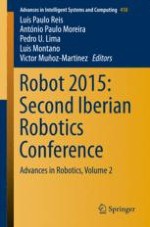This book contains a selection of papers accepted for presentation and discussion at ROBOT 2015: Second Iberian Robotics Conference, held in Lisbon, Portugal, November 19th-21th, 2015. ROBOT 2015 is part of a series of conferences that are a joint organization of SPR – “Sociedade Portuguesa de Robótica/ Portuguese Society for Robotics”, SEIDROB – Sociedad Española para la Investigación y Desarrollo de la Robótica/ Spanish Society for Research and Development in Robotics and CEA-GTRob – Grupo Temático de Robótica/ Robotics Thematic Group. The conference organization had also the collaboration of several universities and research institutes, including: University of Minho, University of Porto, University of Lisbon, Polytechnic Institute of Porto, University of Aveiro, University of Zaragoza, University of Malaga, LIACC, INESC-TEC and LARSyS.
Robot 2015 was focussed on the Robotics scientific and technological activities in the Iberian Peninsula, although open to research and delegates from other countries. The conference featured 19 special sessions, plus a main/general robotics track. The special sessions were about: Agricultural Robotics and Field Automation; Autonomous Driving and Driver Assistance Systems; Communication Aware Robotics; Environmental Robotics; Social Robotics: Intelligent and Adaptable AAL Systems; Future Industrial Robotics Systems; Legged Locomotion Robots; Rehabilitation and Assistive Robotics; Robotic Applications in Art and Architecture; Surgical Robotics; Urban Robotics; Visual Perception for Autonomous Robots; Machine Learning in Robotics; Simulation and Competitions in Robotics; Educational Robotics; Visual Maps in Robotics; Control and Planning in Aerial Robotics, the XVI edition of the Workshop on Physical Agents and a Special Session on Technological Transfer and Innovation.
